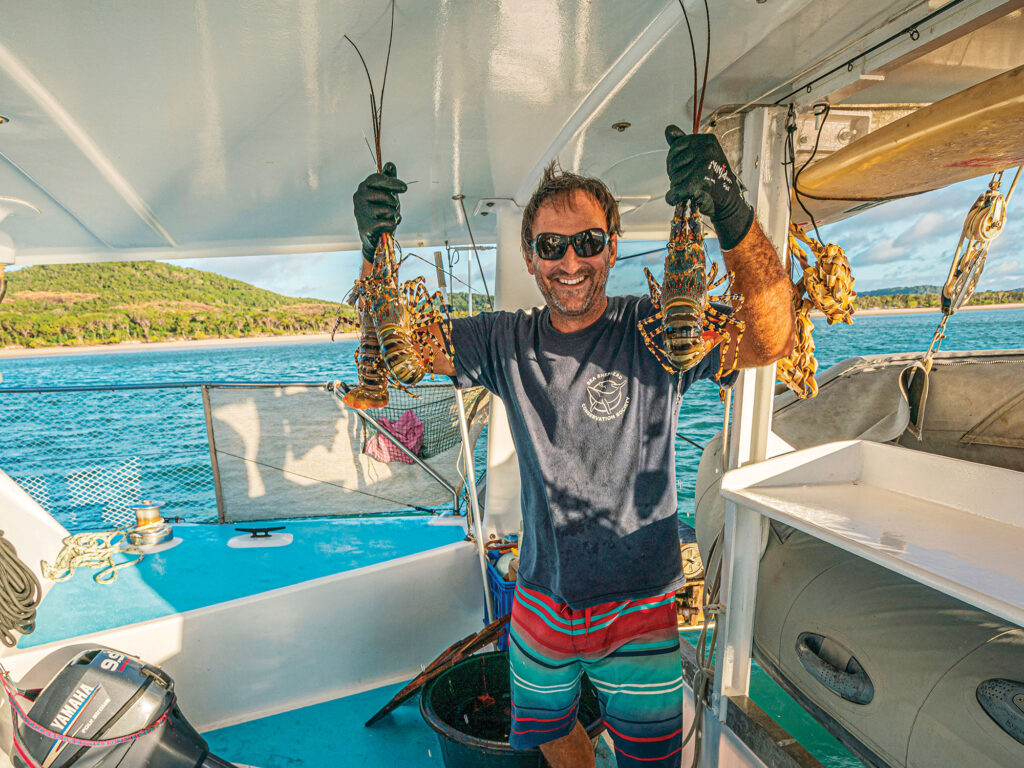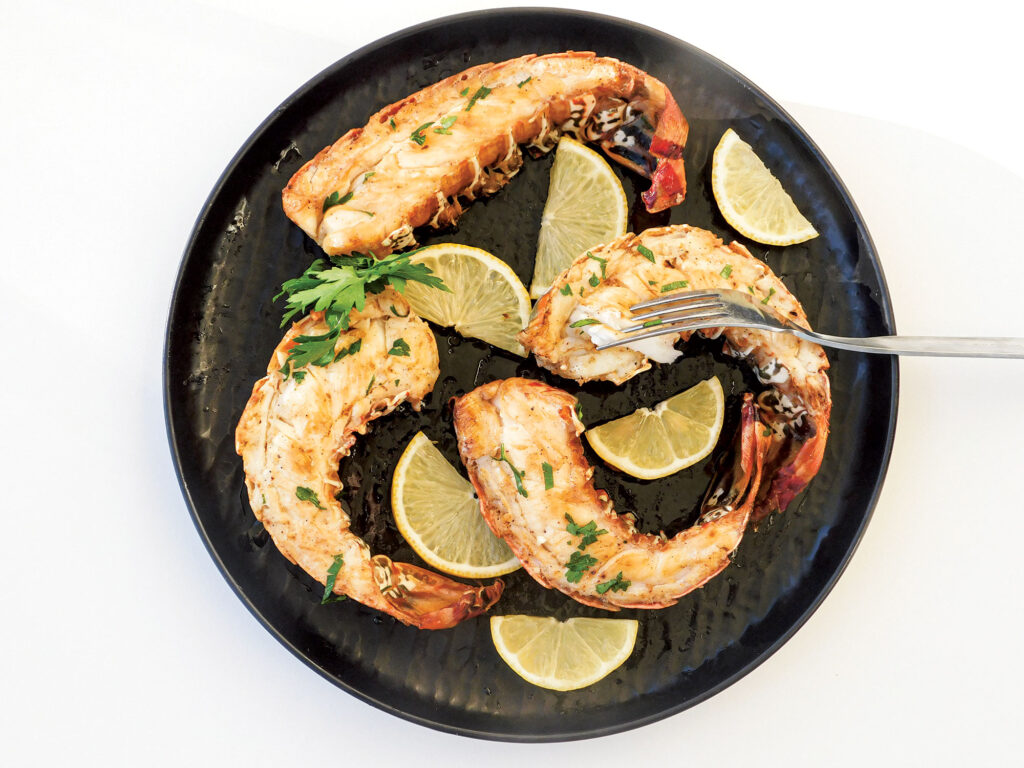Storm-Tossed, Lobster-Blessed: A Culinary Cruising Tale
 David Bristow displays the day’s catch: fresh painted crays, the local name for spiny lobsters in Australia.
Catherine Lawson
David Bristow displays the day’s catch: fresh painted crays, the local name for spiny lobsters in Australia.
Catherine Lawson
My husband, David, and I started our cruising life on a 20-foot trailerable boat. At the time, neither of us had ever taken the helm, but we were avid expedition sea kayakers keen to go farther and see more. More than 20 years later, we’re on boat number five. In all that time, we’ve never lived on land.
Our daughter, Maya, now age 12, was born onto Footprints, our Wharram Tiki 31 (boat number three). She took her first overseas passage on our fourth boat, Storyteller, a 35-foot Hitchhiker catamaran.
Now, all three of us are partway into our first circumnavigation on our fifth boat, Wild One, a 41-foot Grainger catamaran. Our registered home port is Darwin, Australia, but we call Cairns home. We’re all drawn to the sea—an endless horizon that reminds us the world is bigger than we are. Besides sailing, there’s other fun to be had: riding waves, ogling underwater life, and catching meals that come unwrapped, fresh from the source to the table.
Every day at sea is different, even after 20 years afloat. There are inspiring days of such magnificence that we smile just remembering them. Sometimes, days that are blissful and fun can turn challenging in a heartbeat. Yet all of this brings an intimate connection with nature and the sea that, while not always peaceful, is deeply enriching.
On one of those “challenging” days, our meal from the sea came from an entirely unexpected source. We’d been sailing since midnight and were braving trade-wind swells inside the Great Barrier Reef. We raced ahead of gale-force winds gathering quickly to the south. Stormy squalls hid the horizon. There was no place to hide, but we hoped to be tucked around the tip of Cape York and safely at anchor before the weather really went to hell.
The fishing dory came out of nowhere, tossed clean out of the sea, its propeller spinning midair atop an enormous cresting wave. It veered toward us, maneuvering parallel with our surfing catamaran as we battled to hold course.
Over the roar of the waves, we confirmed two things: Yes, we were indeed all mad bastards, and yes, we would most definitely like a catch of fresh painted crays (as we call our local spiny lobsters in Australia). These were thrown over our rails as we surfed wildly at 13 knots.
Dave gripped the helm to keep the boats a safe distance apart. I moved quickly to scoop up the crays before the sea washing over the aft rail claimed them back again.
Minutes later, the dory peeled away, back to its mothership rolling at anchor behind the slenderest of sand cays. With dinner in the bag, we continued, eventually coasting alone through Albany Passage at dusk. We rounded Cape York as the sea finally calmed.
To live on the sea is a dream that many of us turn into reality. Whether at sea full time or only seasonally, sailors everywhere are united by the watery adventures that we take. We’re bonded by the feeling that life is better, simpler and richer when we live it on or near the sea—and most of us agree that a good meal after a challenging passage is always a magnificent one.
After Wild One was safely anchored, we reveled in one of those moments of magnificence. As we savored our dinner of buttery, delicious, pan-fried lobster tails, we lifted our last cold drinks in a toast: to an outstanding day at sea, a tip-of-Australia sunset, and the generous fisherman who’d gifted us dinner.
Buttery Pan-Fried Lobster Tails (serves 2) Buttery pan-fried lobster tails
Lynda Morris Childress
Buttery pan-fried lobster tails
Lynda Morris Childress
- 2 spiny lobsters
- ¼ cup butter, softened
- 3 garlic cloves (or to taste), minced or crushed
- 3-4 Tbsp. dry white wine
- 2 Tbsp. fresh-squeezed lemon or lime juice
- Salt and black pepper, to taste
- Few sprigs of fresh parsley, chopped, plus extra for garnish (optional)
We freeze live lobsters for up to 1 hour before cutting, rendering them motionless and inducing a numb, sleeplike state. Using a sharp knife, make one rapid cut through the centerline connecting the head, chest, abdomen and tail. Separate the halves, then twist and break the tail pieces away from the head (or cut apart with a knife). Pull out any intestines running down the middle of the tail and discard. With sharp scissors or kitchen shears, snip away any spiny bits covering the tail meat. Give the tails a quick rinse, and briefly set aside. (If you catch enough, you can save the lobster heads to make stock.)
Melt butter over low or medium-low heat in a pot big enough to hold tail pieces along the bottom. Add garlic, and gently sauté for about one minute. Add white wine and simmer briefly, until slightly reduced. Add the lemon or lime juice. Add salt and pepper and 1 tablespoon parsley, if using. Whisk to combine. Immediately remove from heat. Pour the sauce into a small bowl, leaving only a flavorful coating in your pot.
Return pot to stove, keeping heat low to medium-low. Add lobster tails, meat side down, and gently sauté (cook time will depend on tail size; average is 5 to 10 minutes). Turn and brush both sides of tails with sauce as they cook. After 5 minutes, check for doneness. If more time is needed, check frequently. Lobster is cooked when meat turns opaque white, with no areas of translucent, grayish flesh. Cooked lobster should easily part from the shell when gently prodded with a fork. To serve, arrange tails on a plate, sprinkle with parsley, and garnish with sliced lemons or limes.
Editor’s Note: This is an edited excerpt from The Hunter & The Gatherer: Cooking and Provisioning for Sailing Adventures by Catherine Lawson and David Bristow.
Calling all galley gourmets! Do you have a personal favorite galley recipe you’d like to share? We’d love to see it. Email your recipe, the story behind it, and two or three high-resolution digital photos of you aboard your boat to [email protected].
The post Storm-Tossed, Lobster-Blessed: A Culinary Cruising Tale appeared first on Cruising World.
- Home
- About Us
- Write For Us / Submit Content
- Advertising And Affiliates
- Feeds And Syndication
- Contact Us
- Login
- Privacy
All Rights Reserved. Copyright , Central Coast Communications, Inc.